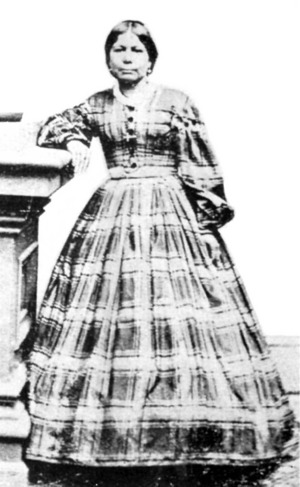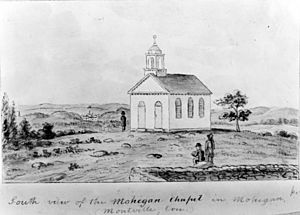Emma Fielding Baker facts for kids
Quick facts for kids
Emma Fielding Baker
|
|
|---|---|
 |
|
| Born |
Emma Fielding Baker
December 5, 1828 |
| Died | January 20, 1916 (aged 87) |
| Occupation | Tribal historian, medicine woman (posthumous) |
Emma Tyler Fielding Baker (December 5, 1828 – January 20, 1916) was a very important member of the Mohegan people. She was a tribal historian and a leader in ceremonies. After she passed away, she was given the special title of medicine woman in 1992. Medicine women were respected leaders who knew a lot about their tribe's customs and history.
Early Life and Family
Emma Baker was born on December 5, 1828. Her birthplace was the Mohegan village in what is now Fort Shantok, Connecticut. She was one of ten children born to Francis Fielding and Rachel Commenwas Hoscott.
As an adult, Emma Baker worked hard to save her tribe's history. She helped keep their old records and oral stories alive. Because of this, she became known as a "culture-bearer." This means she helped pass on the Mohegan way of life to future generations. In 1854, she married Henry Greenwood Baker, a Mohegan man. Together, they had eight children.
Leading the Mohegan Tribe
Emma Baker was a strong leader in her community. In 1860, she became the president of the Church Ladies Sewing Society. This group of Mohegan women worked to protect their tribe's culture. They were very powerful, helping to choose new chiefs and decide who owned tribal land. They met regularly at the Mohegan Church in Montville, Connecticut.
One of Emma Baker's big achievements was bringing back an old Mohegan celebration. This was the Green Corn Ceremony, also known as the "Wigwam Festival." "Wigwam" means "welcome." This festival is still held every year in August. It celebrates Mohegan tribal culture. Holding the festival on church land, which was owned by the tribe, helped keep the tribe together. This was especially important later when their reservation land was divided up. Emma Baker also taught Sunday School at the Mohegan Church.
In 1896, Emma Baker was chosen as president of the Mohegan Indian League. She spoke for the Mohegan Nation to the Connecticut legislature. This group of lawmakers was all white and all male. She worked to protect Mohegan land and sacred sites. She also led the Mohegan tribal council. She wrote down how the Norwich Royal Mohegan Burial Ground was being disrespected. In 1909, she even lent some "Indian Relics" for a display in Norwich, Connecticut. This display honored the town's anniversary. After her death, she was honored by being chosen for the Connecticut Women's Hall of Fame in 1994.
Later Life and Legacy
Emma Baker was a "nanu," which means a respected elder woman or mentor. She taught her niece, Gladys Tantaquidgeon, about tribal spirituality and herbal medicine. Emma had learned these traditions from her own grand-aunt, Martha Uncas.
Emma Baker passed away on January 20, 1916. She is buried at Shantok Burial Grounds in Uncasville, Connecticut. In 2017, an artist named Adam Chambers created a portrait of her. This portrait became an ornament for one of the trees at the President's Park in Washington, D.C. She was chosen because she was a Connecticut native who worked to promote understanding and diversity.
Emma Baker's great-grandson, Ralph W. Sturges (1918-2007), played a key role in the Mohegan Tribe's history. He helped build the Mohegan Sun Casino. The casino opened in 1996 on 240 acres of the tribe's land in Uncasville, Connecticut. With money from the casino, the Mohegan Tribe gave $10 million to the Smithsonian Institution. This money helped build the National Museum of the American Indian.
Images for kids





